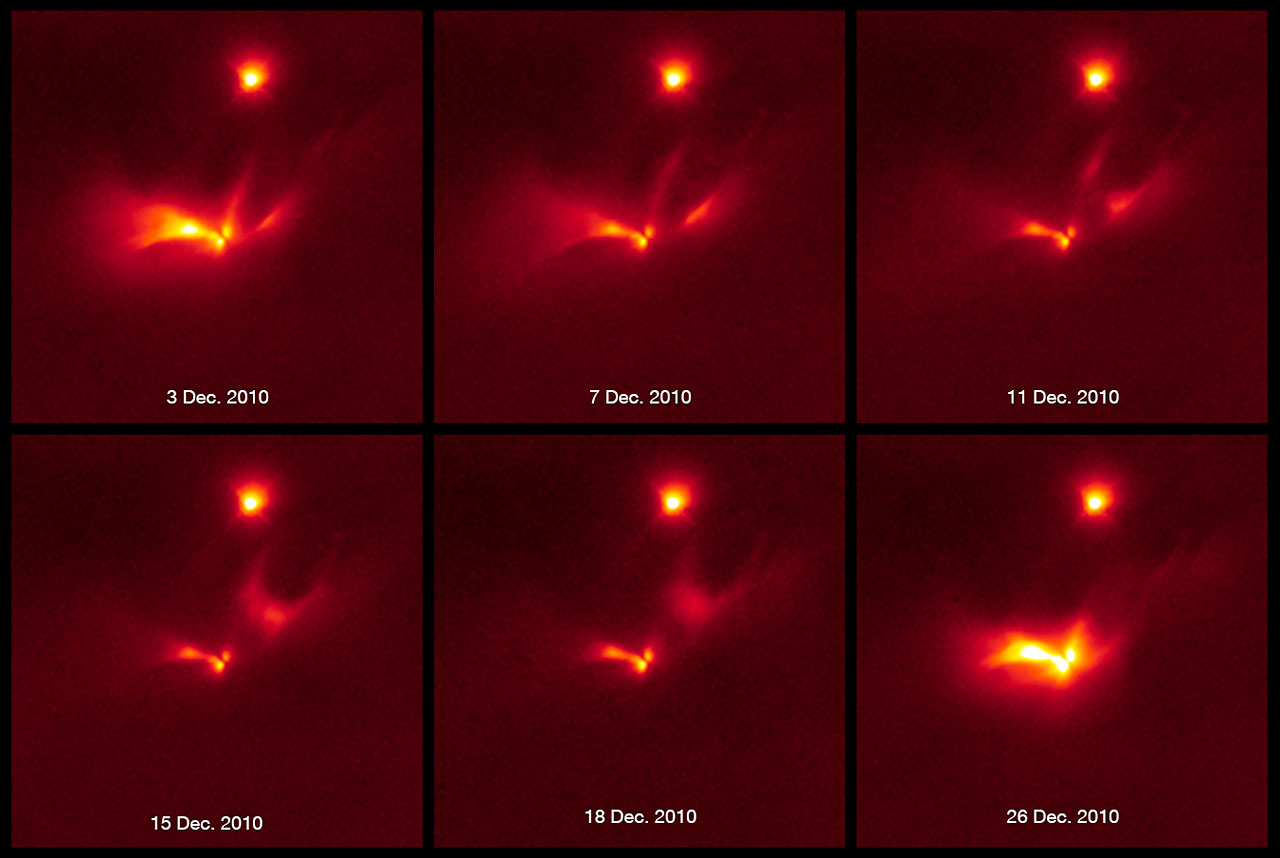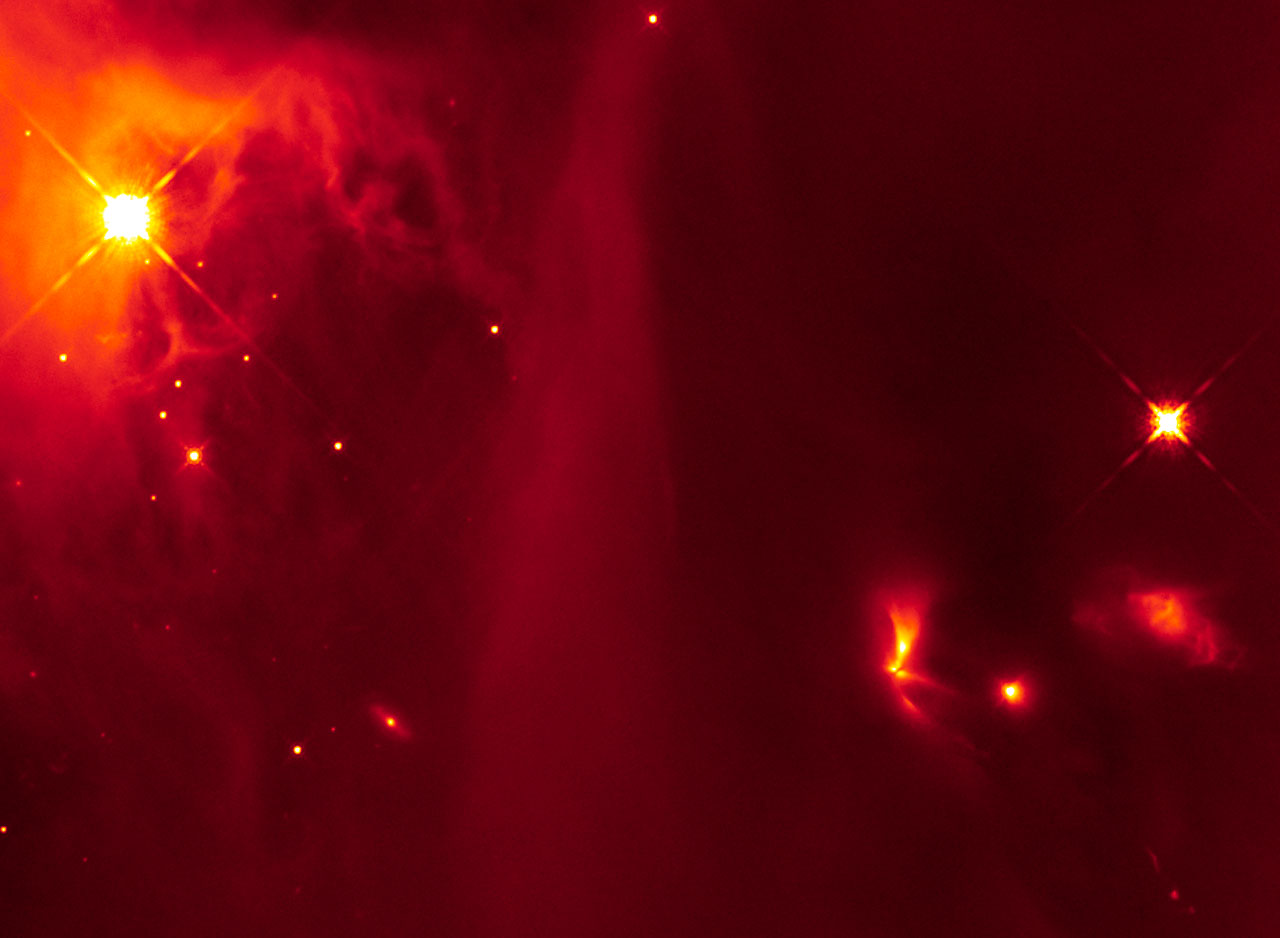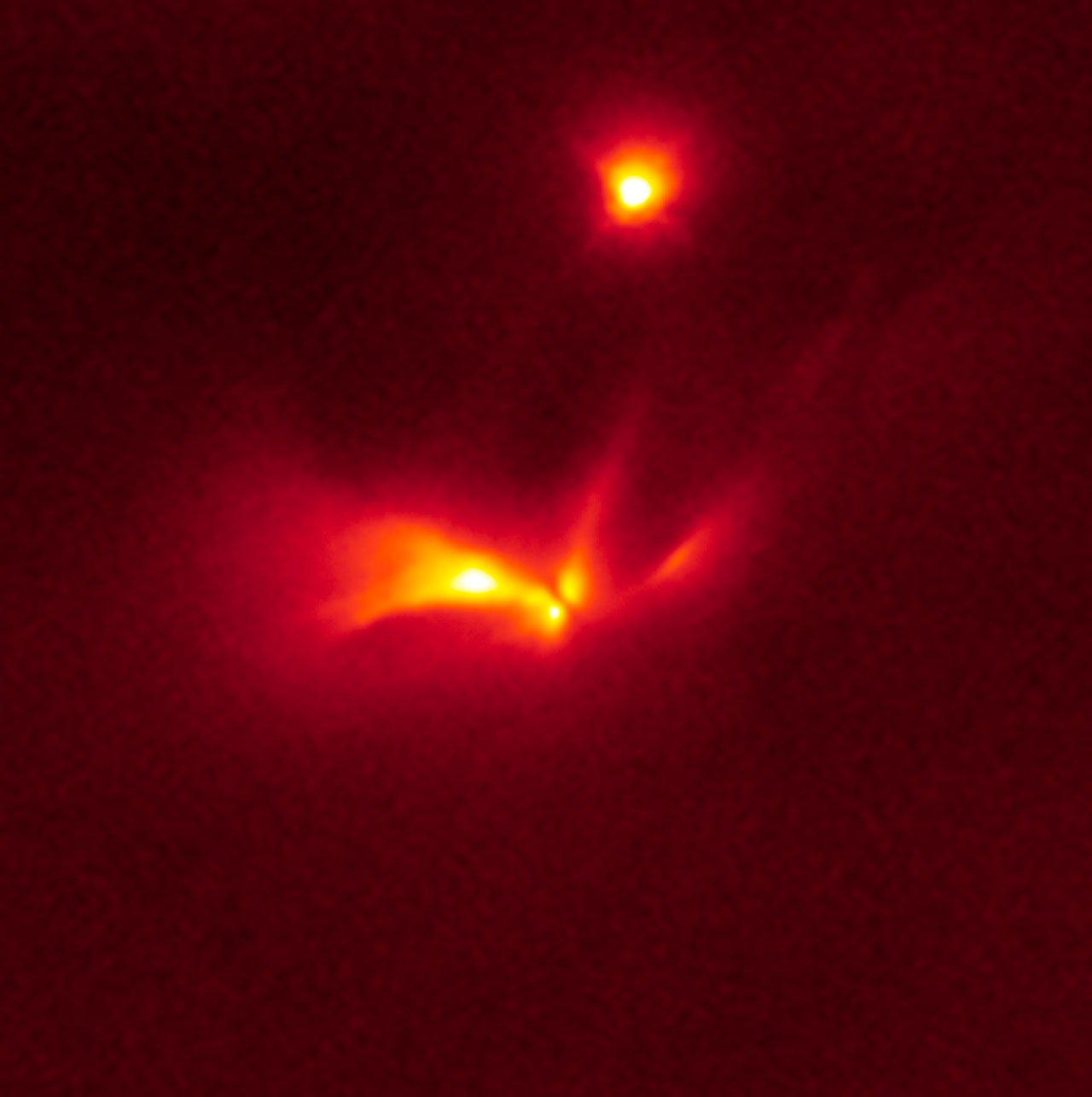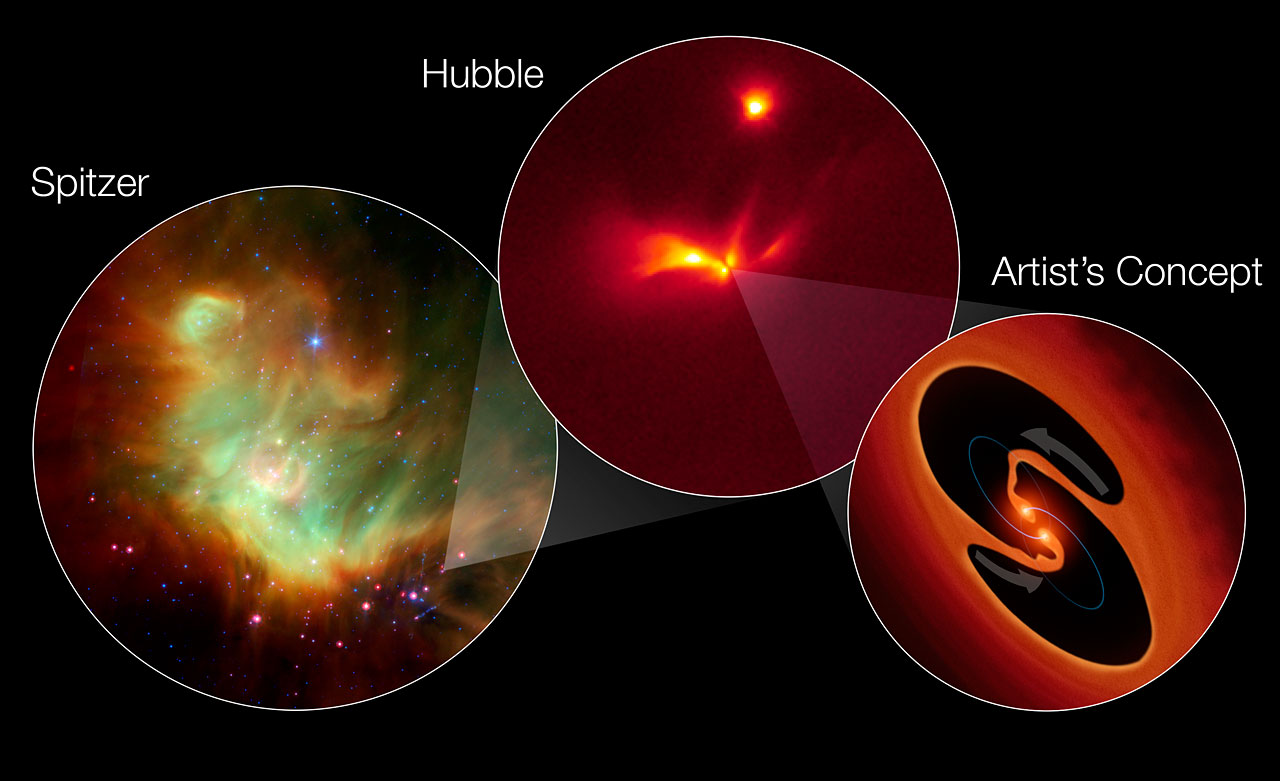It looks like you're using an Ad Blocker.
Please white-list or disable AboveTopSecret.com in your ad-blocking tool.
Thank you.
Some features of ATS will be disabled while you continue to use an ad-blocker.
5
share:
Hello ATS. This just in from Hubble.
More info on the video can be found here




Sorry to post and run but my lasagne is ready!
Please visit the link for further details, images, videos and wallpaper.
Hubble captures strobe flashes from a young star
LRLL 54361
This time-lapse movie from the NASA/ESA Hubble Space Telescope shows a pulse of light emanating from the protostellar object LRLL 54361. Most if not all of this light results from scattering off circumstellar dust in the protostellar envelope.
More info on the video can be found here

This sequence of images from the NASA/ESA Hubble Space Telescope shows a pulse of light emanating from the protostellar object LRLL 54361. Most if not all of this light results from scattering off circumstellar dust in the protostellar envelope.
An apparent edge-on disk visible at the centre of the object, and three separate structures are interpreted as outflow cavities. The extent and shape of the scattered light changes substantially over a 25.3-day period.
This is caused by the propagation of the light pulse through the nebula. Astronomers propose that the flashes are due to material in a circumstellar disk suddenly being dumped onto a binary pair of forming stars. This unleashes a blast of radiation each time the stars get close to each other in their orbit.
These near-infrared light images are from Hubble’s Wide Field Camera 3.

The NASA/ESA Hubble Space Telescope has produced a time-lapse movie of a mysterious protostar that behaves like a flashing light. Every 25.34 days, the object, designated LRLL 54361, unleashes a burst of light which propagates through the surrounding dust and gas. This is only the third time this phenomenon has been observed, and it is the most powerful such beacon seen to date. It is also the first to be seen associated with a light echo.
The cause of the fireworks seen in this Hubble image and video is hidden behind a dense disc and envelope of dust. However, astronomers think that the strobe effect is due to periodic interactions between two newly-formed stars that are gravitationally bound to each other.
These two stars drag material inwards from a surrounding disc of gas and dust. Astronomers propose that the light flashes seen in this video are due to this material suddenly being dumped onto the growing stars as they near one another in their orbits, unleashing a blast of radiation.
The protostar has such large brightness variations with a precise period that it is very difficult to explain,” says James Muzerolle of the Space Telescope Science Institute in Baltimore, USA, who has recently studied this fascinating object using Hubble and NASA’s Spitzer Space Telescope. Spitzer made repeated observations over seven years, before Hubble was pointed towards the object to make detailed observations over the period of one pulse event.
The Hubble observations uncover a spectacular movement of light away from the centre of the system, an optical illusion known as a light echo. While it might look like eruptions of gas are coming out of the protostar, these pulses are actually flashes of light propagating through the surrounding dust and gas and reflecting towards the observer: there is no substantial physical motion within the cloud over these timescales.
Flashing double star systems like this one are rare, because close binaries account for only a few percent of our galaxy’s stellar population. Moreover, the pulsing light is likely to be a brief phenomenon in the early life of a star.

This infrared image from the NASA/ESA Hubble Space Telescope shows an image of protostellar object LRLL 54361.
The protostar is letting off flashes of light every 25.3 days.

This image shows:
On the left, an infrared image from the NASA Spitzer Space Telescope shows LRLL 54361 inside the star-forming region IC 348 located 950 light-years away. The Spitzer Space Telescope discovered the unusual flashing protostar here.
In the centre: This Hubble image resolves the detailed structure around the protostar, consisting of two cavities that are traced by light scattered off their edges above and below a dusty disk. The cavities were likely blown out of the surrounding natal envelope of dust and gas by an outflow launched near the central object.
On the right: This artist’s impression represents scientists’ theory for how and why the protostar gives off these regular flashes of light. Astronomers propose that the flashes are due to material in a circumstellar disk suddenly being dumped onto the growing stars and unleashing a blast of radiation each time the stars get close to each other in their orbit.
Sorry to post and run but my lasagne is ready!
Please visit the link for further details, images, videos and wallpaper.
edit on
7/2/2013 by SilentE because: (no reason given)
edit on 7/2/2013 by SilentE because: (no reason given)
And I thought my bulb had gone again
On a more serious note - thanks for sharing this fascinating information. As technology advanced we said Wow! the world is getting smaller and it seems we're going to be saying the same about Space (Metaphorically speaking).
The veil gets thinner!
On a more serious note - thanks for sharing this fascinating information. As technology advanced we said Wow! the world is getting smaller and it seems we're going to be saying the same about Space (Metaphorically speaking).
The veil gets thinner!
edit on 7-2-2013 by quedup because: (no reason given)
Originally posted by quedup
And I thought my bulb had gone again
On a more serious note - thanks for sharing this fascinating information. As technology advanced we said Wow! the world is getting smaller and it seems we're going to be saying the same about Space (Metaphorically speaking).
The veil gets thinner!edit on 7-2-2013 by quedup because: (no reason given)
Thanks for your reply.
You're right on. All I can say is WOW! It's the sme reaction everytime and always will be. It's like a default setting.
Even if I don't quite understand the science behind a lot of this, atleast I understand the beauty! (That sounds a little bit cheesy but i'm sticking with it.)
new topics
-
Big Storms
Fragile Earth: 32 minutes ago -
Where should Trump hold his next rally
2024 Elections: 3 hours ago -
Shocking Number of Voters are Open to Committing Election Fraud
US Political Madness: 3 hours ago -
Gov Kristi Noem Shot and Killed "Less Than Worthless Dog" and a 'Smelly Goat
2024 Elections: 4 hours ago -
Falkville Robot-Man
Aliens and UFOs: 4 hours ago -
James O’Keefe: I have evidence that exposes the CIA, and it’s on camera.
Whistle Blowers and Leaked Documents: 5 hours ago -
Australian PM says the quiet part out loud - "free speech is a threat to democratic dicourse"...?!
New World Order: 6 hours ago -
Ireland VS Globalists
Social Issues and Civil Unrest: 6 hours ago -
Biden "Happy To Debate Trump"
2024 Elections: 7 hours ago -
RAAF airbase in Roswell, New Mexico is on fire
Aliens and UFOs: 7 hours ago
top topics
-
A Warning to America: 25 Ways the US is Being Destroyed
New World Order: 17 hours ago, 21 flags -
Blast from the past: ATS Review Podcast, 2006: With All Three Amigos
Member PODcasts: 9 hours ago, 13 flags -
James O’Keefe: I have evidence that exposes the CIA, and it’s on camera.
Whistle Blowers and Leaked Documents: 5 hours ago, 12 flags -
Biden "Happy To Debate Trump"
2024 Elections: 7 hours ago, 12 flags -
Australian PM says the quiet part out loud - "free speech is a threat to democratic dicourse"...?!
New World Order: 6 hours ago, 12 flags -
Mike Pinder The Moody Blues R.I.P.
Music: 9 hours ago, 8 flags -
What is the white pill?
Philosophy and Metaphysics: 9 hours ago, 6 flags -
Shocking Number of Voters are Open to Committing Election Fraud
US Political Madness: 3 hours ago, 5 flags -
Ireland VS Globalists
Social Issues and Civil Unrest: 6 hours ago, 5 flags -
RAAF airbase in Roswell, New Mexico is on fire
Aliens and UFOs: 7 hours ago, 5 flags
5
